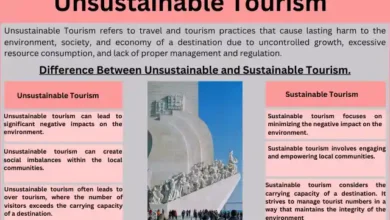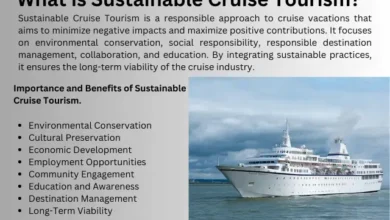
Negative Impacts of Sustainable Tourism
Sustainable tourism has been gaining traction in recent years, with more and more travelers deciding to visit less-developed destinations that preserve the environment and ensure the financial well-being of local communities. There are many benefits to this type of tourism, but there are also some negative impacts of sustainable tourism on the countries being visited. Here’s what you need to know about the negative impacts of sustainable tourism in today’s global economy, plus tips for finding sustainable tours and activities around the world.
What Is Sustainable Tourism?
Sometimes called ecotourism, sustainable tourism uses tourism to advance a broader environmental agenda. From lessening your carbon footprint to preserving native cultures, there are several ways tourists can use their vacations as platforms for good.
But before you hit book now on that all-inclusive trip to Bali, it’s important to understand both the positive and negative impacts of sustainable tourism so you can make informed decisions on your next vacation. Here are some facts about sustainable tourism that might surprise you. First, this form of tourism does not exist in isolation. It has positive and negative impacts just like any other industry or sector. On the one hand, positive impacts may include cultural preservation and biodiversity conservation.
However, too much development can lead to overcrowding which causes serious erosion in places where land is scarce like Costa Rica or Madagascar. And sustainability isn’t just an environmental issue. With rapid global population growth, cities are becoming more crowded, tourist destinations see increased resource consumption with pollution levels rising and economies also suffer from over-development because people have no time off work to travel! This can increase the negative impacts of sustainable tourism.
Why Be Concerned About the Negative Impacts of Sustainable Tourism?
Many people make assumptions about sustainable tourism. Several people think that tourism is bad because it degrades local environments, cultures, and communities. In reality, there are both positive and negative impacts associated with sustainable tourism. The key to long-term success lies in fully understanding what these impacts are. Here is a list of positive as well as negative impacts of sustainable tourism.
Understanding what the positive and negative impacts of sustainable tourism look like on a local level will help you evaluate whether your business is making an impact or helping to create awareness for various causes such as environmental sustainability or responsible entrepreneurship.
Once you’ve identified the possible positive and negative impacts of sustainable tourism, you can plan the best way to deal with them while still being profitable. These positive and negative impacts typically include social, economic, cultural, ecological, aesthetic, and political impacts.
As one example: if visitors to your site spend more money than residents do within a certain time frame this could be considered as having a positive economic impact; but if visitors consume more resources than residents this could be considered as having a negative ecological impact. Evaluating all the potential impacts before starting any project ensures you’re planning and staying conscious of the effects that tourism has on our environment.
How Can We Reduce The Negative Impacts of Sustainable Tourism?
Although travel has both positive and negative impacts, we have an opportunity to encourage sustainable tourism around the world. With as little as a $1 donation, organizations like Conservation International can plant 10 trees in Ecuador. Every time a tree is planted it is said to remove up to 50 lbs of carbon dioxide from our atmosphere.
If each tourist donates just one dollar for every mile they travel, that translates into thousands of trees planted per trip. By changing the way we think about travel, we can make a huge difference. The positive and negative impacts of tourism will change with people’s choices and actions.
Even though there are both positive and negative impacts of travel, sustainable tourism does not have any downsides because it brings economic benefits to locals, promotes local cultures, improves natural resources, and even provides jobs. If we choose more wisely where we want to visit, and when, the positive impacts of sustainable tourism will outweigh the negative. We all want our future generations to be able to experience what we do now without harming nature or abusing other countries for profit.
How Can We Reduce These Impacts? Although travel has both positive and negative impacts, by making small changes like donating $1 for every mile traveled or traveling during off-peak seasons this problem can be reduced drastically.
What can you do to reduce the negative impacts of sustainable tourism? As consumers, we have the power to reduce these impacts by choosing destinations with low impact on the environment and avoiding travel during peak seasons. As travelers, we need to educate ourselves on how our decisions affect these two areas.
Educating yourself is key when planning your next vacation so you can pick destinations responsibly. The positive and negative impacts of sustainable tourism depend largely on individual choice but no matter what you decide, you should always try to make a positive impact where possible.
Negative Impacts of Sustainable Tourism; Global Measures
Not only has travel seen an increase in popularity over recent years, but a growing number of countries are taking steps to support sustainability. A good example is Costa Rica, which for years had been dependent on tourism as a primary source of income, but experienced rapid growth in both domestic and international tourism. As a result, the government passed laws that would prohibit hotels from being built near national parks or other protected areas.
The idea behind this law was to prevent high-density development that would threaten natural habitats and ecosystems. In response to their issues with tourism-related degradation, many regions have begun implementing new initiatives aimed at protecting their most important natural resources. One such initiative includes purchasing large tracts of land around scenic locations like forests and wetlands so that future generations can enjoy them just as we do today.
More recently, there has been interesting in adding ecological corridors along transportation routes so that wildlife can safely cross the road without running into traffic. With projects like these continuing to take place around the world, sustainable tourism may become a reality.
Why Is It Important to Reduce the negative impacts of Sustainable Tourism?
The impact of tourism is considered a growing concern. It’s estimated that by 2020, one billion international tourists will be traveling abroad to visit foreign countries. The hope is that sustainable tourism initiatives can help mitigate negative environmental impacts on communities and local resources. We’ll look at both positive and negative impacts to form a better understanding of what sustainability looks like in practice.
When you consider all aspects of travel, it’s easy to see how both positive and negative impacts come into play. As an example, some travelers purchase items made from or containing palm oil because they contain good-for-you fats. However, these products are often harvested through deforestation efforts which destroy the habitat of animals along with their food sources.
Deforestation has been linked to climate change since it affects the carbon storage capacity of the planet as well as water cycles. While many travelers might think that buying sustainable goods such as those made from organic cotton makes them Eco-friendly, there are still more factors to consider such as the safety and ethical treatment of workers who produce them. For example, one textile company’s sustainability practices have not translated to safer working conditions for its employees where poor conditions led to strikes.
How To Do It Right?
If you’re planning a vacation that involves Eco-tourism, make sure to find out how sustainable it is. Ecotourism has both positive and negative impacts on destinations worldwide. On one hand, ecotourism can bring in huge revenue that allows local communities to thrive while promoting preservation efforts; on the other hand, poorly executed trips may undermine conservation work or damage delicate ecosystems by overcrowding them with people.
How do you avoid this? Make sure to do your research before booking any tours! The money you spend could end up going towards unsustainable tourism practices. Research whether your tour company has sustainability certifications, if they have an environmental policy statement, if they have strong partnerships with locals and government officials, what their social responsibility program entails (e.g., where they give back locally), etc. When considering your trip’s impact, don’t forget about more than just the environment–consider how the trip will affect culture and society as well.
It’s not enough to be environmentally friendly, but respectful of other cultures as well. A good rule of thumb is to try to plan activities that benefit locals’ needs rather than imposing your agenda. For example, if you want to go whale watching, consider taking a boat run by locals for which all proceeds go directly into community development projects.
The Dangers of Going Green:
While going green is often a priority for many businesses, it’s important to consider some negative impacts of being environmentally friendly. If you are trying to be sustainable but also want to keep your expenses down, consider these positive and negative impacts before starting a new sustainable project. *Making the environment safer: *One of the biggest benefits of a business that focuses on sustainability is that they create an environmentally friendly environment.
By focusing on sustainability, not only do you make the environment safer for the people in your community, but you make it easier for future generations to live healthy lives as well. In addition, businesses have been able to save money by using renewable energy sources and reducing their water consumption as well as greenhouse gas emissions through more efficient equipment.
However, while creating a sustainable space can be beneficial for everyone involved, there are also disadvantages. One disadvantage is that implementing sustainable practices takes time; if your company doesn’t give enough time to research or plan out how to implement sustainable practices then this can result in wasted money and resources without any progress made toward becoming more environmentally conscious.
There are many dangers to be aware of when going green. Green doesn’t necessarily mean organic, sustainable, or natural. However, there are steps you can take to minimize your risk when becoming greener. Here are a few tips.
1) If you have kids who still need naps, turn off the AC and open the windows for them.
2) Save energy by drying clothes on a line in the backyard rather than using an electric dryer (which is most often gas-powered).
3) Keep your car at home as much as possible- biking, taking public transportation, or carpooling with friends is healthier for everyone!
4) Plant a tree in your neighborhood to help offset some of the carbon footprint left by all of us driving around in our cars.
5) Consider renting out a bicycle if you’re traveling somewhere where it’s appropriate- it’s cheaper, less environmentally damaging, and faster than driving or flying.
Conclusion:
One way to evaluate whether tourism is sustainable is to measure its positive and negative impacts on a community. For example, visitors’ purchasing power can benefit local economies, which in turn creates jobs for native workers. This new income can positively affect communities by providing locals with opportunities for education and health care.
On the other hand, increased development from hotels and visitor attractions can put pressure on the environment. If unchecked, this will result in environmental degradation such as water pollution and depletion of natural resources. To assess whether or not tourism is sustainable we must consider both the positive and negative impacts of sustainable tourism it has on the destination community.
Positive impacts include the purchase of goods and services that are produced locally which increases the economy of that region. Additionally, tourists may provide additional economic opportunities through employment within their hotel or tourist attraction business. However, over-development is one of the negative impacts of sustainable tourism. Moreover, the environment such as creating water pollution and depleting natural resources. Ultimately, sustainability should be based on a balance between the positive and negative impacts tourism has on communities.




